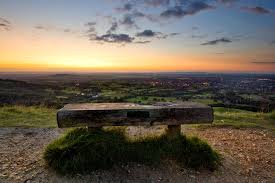Richard Lutz roams through another week.

To the top of Leckhampton Hill, which looks northward over Cheltenham. It’s at the edge of the Cotswolds and it’s on the edge of winter. As usual, wander a millimetre off a main trail and you are alone.
I walk around a big escarpment. It is biting cold with a northern breeze and a low sun. But as in all British walking, as long as it’s not raining, it’s okay. “There’s no such thing as bad weather,” said a nature writer. “Just bad clothing.”
The beauty of this walk is not only the continual roll of hills but also the proliferation of ancient Iron Age hill forts, Roman encampments, ‘barrow’ burial sites, timeless tumulae, dead medieval villages and little bumps and outlines of earth that are the fingerprints of man going back 5,000 years.
The architecture expert Nicholas Pevsner, who catalogued almost everything in England county-by-county if it contained more than three bricks piled together, goes into great details about these Old Things that you slog by and shrug off as just big lumps or bumps.
For instance, take the chambered Long Barrow of Coberley, south of Leckhampton Hill. This is the detail he offers, “2.5m WNW of the church, known as Shurdington Barrow. It is 190 ft long. A flat stone, 6ft long, is exposed at the E end. A burial chamber containing a skeleton was found there before 1779. Two smaller mounds near by.”
I like the two “smaller mounds near by.” Maybe those were originally the more important, a burial site for a king, a monument to a queen, a baleful epitaph to an appalling defeat or where a shocked priest met his god. But now just a footnote to a barrow.
We pass it. It is covered by ivy and a rambling mess of blackberry bushes. No wonder it is called a long barrow. 190 feet of Longness. In the fading winter light, it dominates a crest above us as we follow an old drove road down a valley back to the car.
Back home, I am two weeks living alone as others attend to business. These days alone will end soon. It means doing a bit of cleaning.
Trails of a fortnight’s business and busyness (and sloth) twist and turn through every room. Here a line of post unopened, spoons everywhere, books with bookmarks noting where I fell asleep before I turned a page.
Lots of shoes that are kicked off and abandoned. A plate with indeterminate crusted crumbs. Too many hats scattered on surfaces. I was scrupulous over the kitchen.A good boy.
But the rest of the house has everywhere trails and paths of living a life. And no Pevsner to define it. I’ll start gathering it all up tomorrow.



My “Country Walking” magazine has a recent issue on walking to hill forts
Pevvo !!
If you walk the ridges in our part of the world in Herefordshire, at present you would look down on a system of lakes. The floods are more extensive than I can remember.
Takes me back down memory lane.
Very erudite when it comes to cleaning